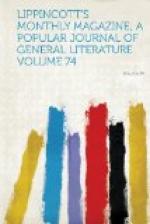But some varieties of beauty in the coral belong to calmer seas: among others, the Red Sea is noticed for the exquisite loveliness of its coralline formations. An American explorer, well known in submarine diving, once visited that gulf sacred in history, and for a purpose certainly as singular as anything he found there. It was, to use his own words, “to fish for Pharaoh’s golden chariot-wheels,” lost in that famous pursuit. Is it possible, in the nature of things, for such an expedition to be made by any but an American? It takes a strong Bible faith, allied to a simple but strong self-confidence, to start a man on such an adventure. The curious transforming magic of the sea had its effect on the Arab dragoman he had engaged to assist him. Having settled on the exact spot, the swart Arabian descended, but signaled to return almost immediately, and was brought to the surface in open-eyed wonder. With all the hyperbole of Oriental imagination he swore positively to the finding of the chariot-wheels, and added the jewelry of Pharaoh’s household. He was so earnest and so exact in the matter of the golden wheel, set with precious stones, that, though the captain dryly asked if he did not meet King Pharaoh himself, taking a moist throne and keeping court with the fishes, he none the less had the line attached and drew up—the rude wheel of a Tartar wagon, transformed under water, but plain and ugly enough above.
“The djin did it,” explained the Arab. “It is a palace of the djins, howadji.”
Though the adventurous explorer failed in his design on the defunct Egyptian, he was rewarded by some compensating views and discoveries. He saw there the Xenia elongata, a shrub-like coral distinguished for the beauty of its colors, having stellar tentacles, rose-colored, blue and lilac, an inch in diameter, and looking like flowers of living jewelry; another with a long cue, like a tress of hair, and others of allied beauty.
The coral-stone is seen and admired on centre-tables and in jewelry, but this is really the least pleasing beauty in the organism. The animal, subjected to exposure, is a brown mucus that dissipates in the sun and air, but clothed in its native element this glutinous substance is instinct with radiant life, the bodies being rose-color and the arms a pure white. Sometimes they grow in clusters and corymbs, gleaming with a pure, translucent color that fluctuates and changes in the light
Like
colors of a shell,
That keep the hue and polish of the wave.
Our searcher found one unexpected verification of the story in Exodus. The passage in the Bible does not leave altogether in mystery the natural means by which the transit was effected. We are told of the strong east wind and the wall of waters. At the point near Suez a shoal extends quite across the sea. For several days this wind had borne back the shallow waters, descending as it did from the rugged mountain-slopes, and opening or sweeping




